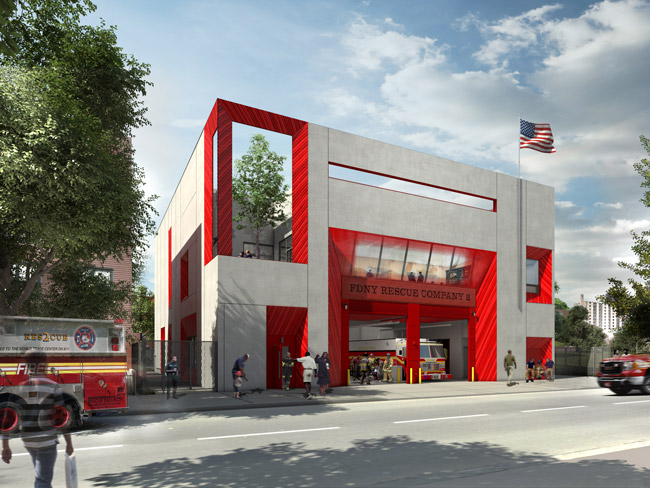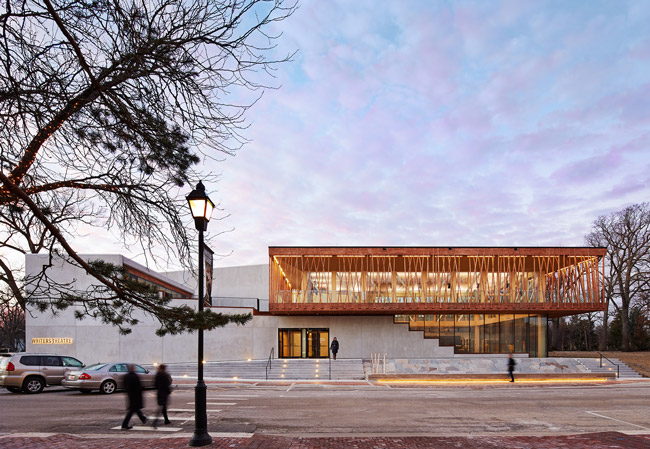by: Anna Gibertini
On 03.24.17, two of the biggest names in architecture stopped by the Center for Architecture for a lively evening of illumination and calls to action. Once the crowd of 180 fans filed into Tafel hall and the mezzanine balcony, AIANY and Center for Architecture executive director Benjamin Prosky warmed up the crowd for the two giants who, as he noted, needed no introduction: Jeanne Gang, principal of Chicago-based Studio Gang, and Michael Kimmelman, New York Times architecture critic.
Eben Klemm, MIT chemist-turned-bartender and author, provided the evening’s custom cocktail, the “Chain Gang,” using ingredients all either homemade or sustainably sourced—a nod to Studio Gang’s dedication to environmentalism. A full list of ingredients is provided at the end of this article.
Gang began the evening with a brief presentation of recent works that tie the tangibility of materials and design with the quest for intangible, capital-T “truth” in architecture. She quickly zoomed in on what this meant for The Arcus Center for Social Justice Leadership in Kalamazoo, MI, a building graced with floor-to-ceiling windows and organized around three axes. Daylight suffuses spacious, crisp white interiors—a physical manifestation of the intellectual illumination happening within—and the spatial arrangement results in naturally occurring interiors that facilitate less structured meetings.
Gang focused on the façade’s white cedar wood masonry: “The wood channels the ancient, tribal architectures of meeting places,” she explained, going on to describe the “incredible resonance” between people and wood. “The client [Kalamazoo College] really liked the community-oriented aspect and historicism the wood masonry brought to the building,” Gang said.
For The Arcus Center, the use of wood masonry resulted in a building that channels traditional social justice spaces—churches, private homes, kitchen tables—into an academic building for tomorrow’s leaders. The wood also acts to sequester carbon, continuing the center’s social justice mission in the realm of environmental protection.
Studio Gang’s Polis Station in Chicago continues the quest for truth through design. Studio Gang initiated the project through engagement with Chicago’s 10th district residential community, police officers, and public officials. This lead to the construction of a half-court in the police parking lot. The positive effect of this court, bringing police and youth together in a non-confrontational way, has resulted in a third phase of the project, which will see an expansion of the half-court into a full-sized one and new amenities.
Kimmelman began the moderated discussion by asking Gang about an architect’s relationship to the public and truth. “We’ve been too long separated from the public,” she replied.
“Some architects would say that public engagement compromises too much [creativity],” Kimmelman remarked.
“It doesn’t,” Gang countered. “There’s a continuum of ways to engage people. We’re not asked to engage with the public, but we should be practicing more outreach.”
Prosky quickly jumped back in to agree, saying, “Rather than architects complaining about not having a seat at the table, we need to learn to show up, talk to people and never assume or demand a place.”
Naturally, that led to a conversation about the current political climate.
“We’re going to be asked to do more for our communities,” Gang said. “Our responsibility is to identify where we can be more active. It’s going to be a hard time. We must reach out and join forces with others and take stands. We’ll need to figure out strategies, be more active and be more participatory.”
Kimmelman agreed, reiterating Prosky’s adlib about humility: “Architects bring terrific problem solving skills [to large scale societal issues]. You can provide something useful and needed. But, you can’t just claim a seat at the table, you have to earn it,” he said. “Trump’s policies are a call to arms and an opportunity to defend things like public housing. We have to get away from this idea that all development is gentrification.” Kimmelman concluded, “What we need now is thoughtful development. Architecture will be at the forefront of addressing this in the immediate future.”
Eben Klemm’s “Chain Gang”: Beach Plum gin, dry vermouth, rhubarb liqueur, absinthe, celery bitters, orange bitters, ginger ale and basil for garnish.
Event: Cocktails & Conversation: Jeanne Gang and Michael Kimmelman
Location: Center for Architecture, 03.24.17
Speakers: Jeanne Gang, FAIA, Founding Principal, Studio Gang
Organized by: AIANY Architecture Dialogue Committee













